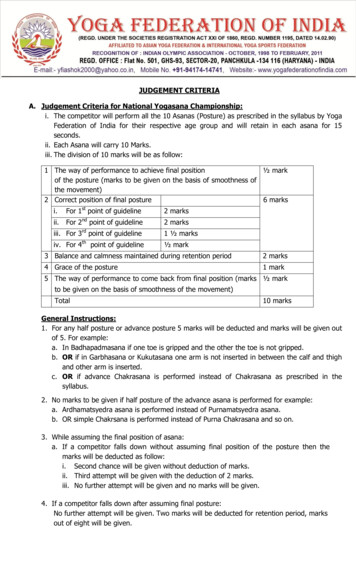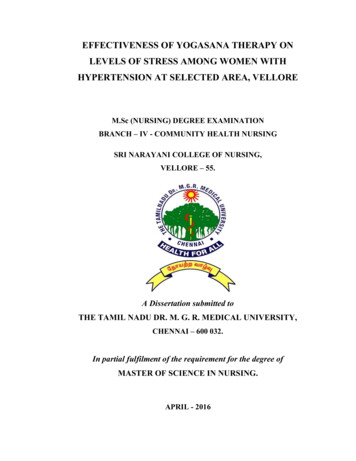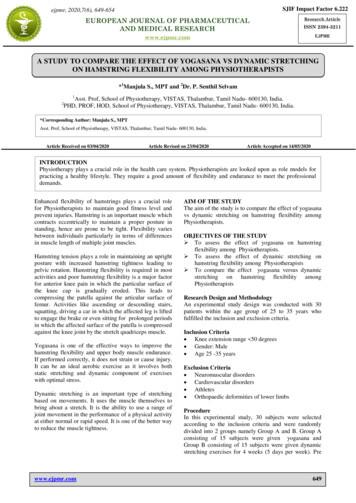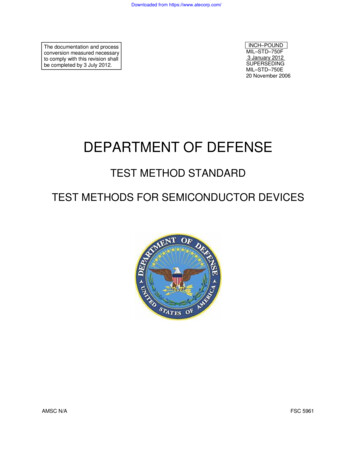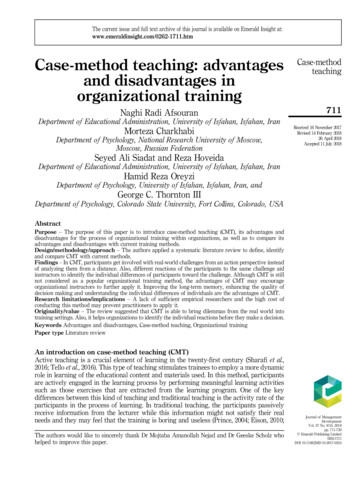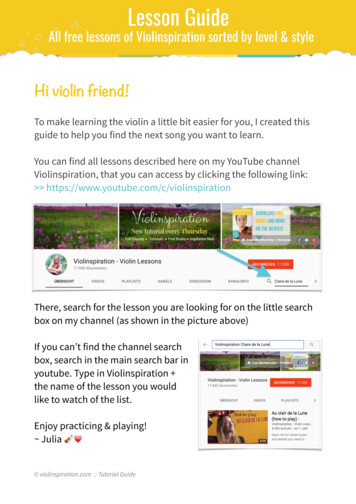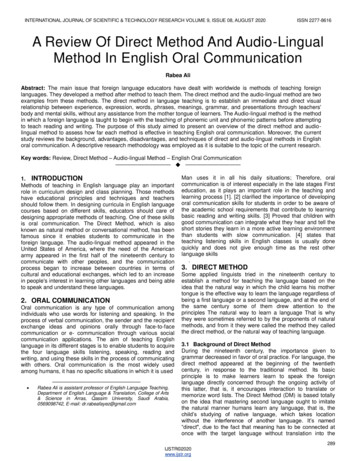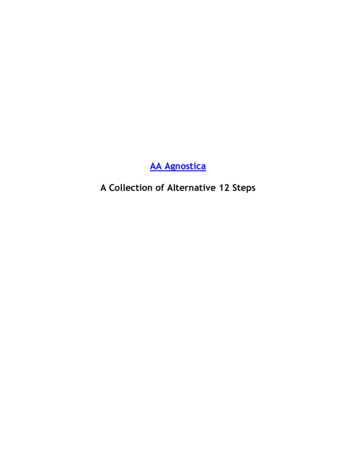
Transcription
Yogasana Teaching (8 steps method)8 Steps method of teaching Yoga Asanas:Yogasanas are physical postures often imitating the natural positions of thee animalsmeant to make the mind tranquil, i.e physical revitalization, deep relaxation and mentalcalmness are achieved.1. Start session with the prayer:Adopt any comfortable meditative posture with namaskara mudhra, spike, neck and headerect. Prayer to be conducted in lead and follow menner. After completing prayer bendforward with a sense of surrender. Meaning of the prayer to be explained.“Om Sahanavavatu, Sahanou bhunaktu, Saha viryam karavavahai,Tejasvinavadhitamastu, ma vidvisavahaiOm Santih, Santih, Santih”Meaning:May he protect us both (the teacher and the student). May he nourish us both. May weboth work together with great energy. May our study be enlightening and fruitful. May wenot hate each other. Om Peace, Peace, Peace.8 step method is a teaching technique used to teach asanas. In any Yoga class,irrespective of level of student, teacher must give clear instructions for each step of Asanapractice in order to make sure every student does with proper understanding, necessaryprecautions, care and perfection.Follow are one of the defined sequence for preparation and practice of Asanas in aYogasana class:1. Introduction (Name, meaning, sthiti, relaxation, complementary, counts,category and type)2. Demonstration (Silent Demonstration, demonstration with count,demonstration with counts, breathing and explanation)3. Limitation and benefits of the asana,4. Individual practice5. practice in pair6. Questions and answers,7. Key points8. Whole group practice with closing prayerFollowing are some of the Asanas given in 8 step method of practice:WWW.MANAVATA.ORGPAGE 1
Yogasana Teaching (8 steps method)Sarvangasana Type: SupineCategory: CulturalCounts:8Complimentary Posture: MatyasanaBenefits1. Stimulates the thyroid gland.2. Influences the pelvic organs.3. Helps to cure varicose veins, piles, hernia.4. Helps to cure constipation and menstrual disorders.LimitationsThose who have Cervical spondylitis, Severe Hypertension should avoid thisKey Points1. Trunk should make 900 to the ground.2. Legs should be straight.3. While supporting the body elbows should be close to each other.4.While bringing the legs down careshould be taken not to raise the head.Practice Steps: (Sthiti: Supine posture)1. Inhale, raise the legs together slowly and gracefully (without bending the knees)till it forms about 45 degrees to the ground2. Continue to inhale and raise the legs further to 90 degree position. Bring the armsdown and place them next to the buttocks.3. Exhale, raise the buttocks and the trunk, taking support of the arms and elbows,without lifting the head. Rest the elbows on the ground firmly and support the backwith both palms4. While retaining the legs parallel to the ground, straighten the trunk by pushing itwith the hands until the chin is well-set in the suprasternal hollow.5. Inhale and raise the legs vertically keeping the body erect and come to the finalshoulder stand position.WWW.MANAVATA.ORGPAGE 2
Yogasana Teaching (8 steps method)6. Maintain effortlessly with normal breathing for about 2 to 3 minutes. Carefully avoidall jerks7. Slowly come back to sthiti and relax in SavasanaMatsyasana: Type: SupineCategory: CulturalCounts:8Complimentary Posture:SarvangasanaBenefitsGood for curing asthmatic, respiratory, diabetes problem.LimitationsThose who had recent chest or abdominal surgery, Cervical spondylitis should avoid thispose for 3 months.Key Points1. Crown of the head on the ground.2. Press the elbows on the ground and allow the weight of the body to go to groundthrough elbows.3. Give a nice backward stretch for dorsal and cervical spinesPractice Steps: (Sthiti: Supine posture)1. Take the right leg and place it on the left thigh2. Plae the left leg on the right thigh as in Padmasana3. Place the palms on either side of thee head with fingers pointing towards theshoulders.4. Inhale, take the weight on the palms and lift the head and the back off the ground.5. Bring the centre of the crown of the head to the ground by bending the dorsal andcervical spine backwards6. Exhale and remove the hands after the weight is well-balanced on the head andcatch hold of the big toes hooking the index fingers around them.7. Press the elbows on the ground to bear the weight of the upper half of the body8. Maintain this position for one minute with normal breathing9. As you exhale come back slowly step by step to supine sthiti10. Relax in SavasanaWWW.MANAVATA.ORGPAGE 3
Yogasana Teaching (8 steps method)Sirshasana: Type: SittingCategory: Cultural-BalancingCounts: 10Complementary Posture: NillBenefitsDue to improved circulation to the brain the whole nervous system becomes healthy.Memory improves. Endocrine glands such as pituitary and thyroid get revitalised. Helpfulin hernia. Seminal weakness can be cured. Improves concentration power remarkably.LimitationsThose who are with running ears, heart trouble, high blood pressure and weak eyecapillaries should not practice Sirsasana.Key Points1. Crown of the head should be on the ground andsupport the back of the head.2.the interlocked palms shouldThe elbows and the head together make an equilateral triangle3. Beginners should do very slowly. Maintain short time.4. Practice under guidance.5. After returning to shiti it is mandatory to rest for a while in the following position.6. Make a fist of both the palms and place them one above the other in front of theknees. Slowly bend forward to rest the forehead on the pressure in the head getslighter. Then relax in Tadasana so that the pressure in the head comes back tonormalcy.Practice Steps: (Sthiti: Vajrasana)1. Place forearms on the blanket in from of you with the fingers interlocked andelbows in front of the kneesWWW.MANAVATA.ORGPAGE 5
Yogasana Teaching (8 steps method)Distance between elbows should be equal to the distance from each elbow to theinterlocked fingers, forming an equilateral trianglePlace the crown of the head on the blanket in between the interlocked handsSlowly raise the buttocks and lift the knees off the ground and straighten the legskeeping the toes on the floor. (ardha sirshasana position)2. Slowly walk towards the trunk and head until the back reaches vertical3. Bend knees slightly, press the thigh against the abdomen and lower chestTransfer the body weight slowly from the toes on to the head and arms, maintaina study balance4. Lift the feet off the ground to about 20 cms, carefully balance on the head and thearms5. Bending the knees, gradually raise the calves in a controlled movement. Adjust thetrunk slightly to counter balance the weight of the legs6. Fold the legs back so that the heels move towards te buttocks7. To accomplish this movement, contract the muscles of the lower back. The kneesare now pointing down with the legs together8. Maintain this position for a few seconds, being aware of complete balance beforeproceeding9. Slowly straighten te hips so that the thighs move up, bringing the knees to verticalposition, keep the heels near the buttocks.10. Straighten the knees until the legs are in line with the trunk. The whole body shouldbe in one straight line with the feet relaxed. Balance the body.11. Maintain the position for one minute with normal breathing12. Return to sthiti reversing the steps with control on each movement.Vustrasana: Type: SittingCategory: CulturalCounts:8Complimentary Posture:PascimotanasanaBenefitsImproves Spine Flexibility, increases circulation to head region.LimitationsRecent chest or abdominal surgery, sever hypertension, hernia and lower back pain mustbe cautious!Key Points1. Push the abdomen forward and see that thighs are perpendicular to the ground.WWW.MANAVATA.ORGPAGE 6
Yogasana Teaching (8 steps method)2. Both legs may be separated by shoulder width apart initially; with practice one canbring them together.Practice Steps: (Sthiti: Dandasana)1. Sit in Vajrasana2. Stand on the knees3. Place the palms on the waist with fingers pointing forward4. Inhale and bend the trunk backwards and place the palms on the heels5. Maintain for about a minute with normal breathing6. Exhale while coming back to Sthiti7. Relax in Sithila Dandasana8. SthitiClosing Prayer:योगेन चित्तस्य पदे न वािाां । मलां शरीरस्य ि वैद्यकेन ॥योऽपाकरोत्तमां प्रवरां मनु ीनाां । पतञ्जललां �स्म ॥Yogena Cittasya Padena Vaacaam Malam Shariirasya Ca Vaidyakena Yo[a-A]paakaro[a-U]ttamam Pravaram Muniinaam Patan.jalim Praan.jalir-Aanato[a-A]smi Meaning:I bow down to Sage Patanjali who has given us Yoga to purify the impurities ofthe Mind (by removing the Chitta Vrittis), Pada (Grammar) to purify the expressionof) Speech and who has given us Vaidya (Medical Science) to purify impurities ofthe Body, He who is an expert in removing (the impurities of the Body, Mind andSpeech), to that most excellent of Munis, (Who is) Patanjali, I bow downwith folded hands.WWW.MANAVATA.ORGPAGE 8
Yogasana Teaching (8 steps method) WWW.MANAVATA.ORG PAGE 1 8 Steps method of teaching Yoga Asanas: Yogasanas are physical postures often imitating the natural positions of thee animals meant to make the mind tranquil, i.e physical revitalization, deep relaxation and mental calmness are achieved. 1. Start session with the prayer:
